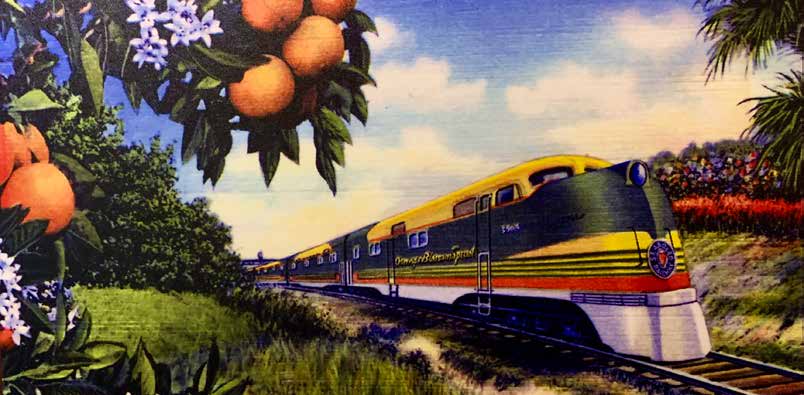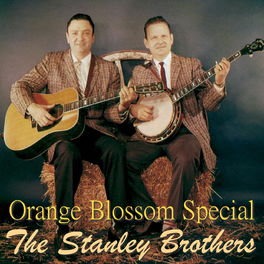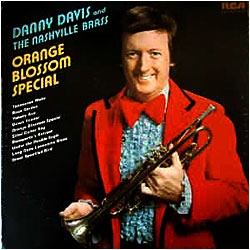“Look a-yonder comin’
Comin’ down that railroad track
Hey, look a-yonder comin’
Comin’ down that railroad track
It’s the Orange Blossom Special
Bringin’ my baby back” – Orange Blossom Special (Ervin Thomas Rouse) © Sony/ATV Music
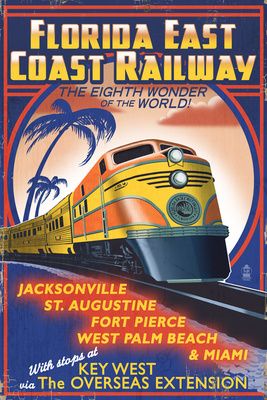
In the 1920s, the state of Florida found itself in the midst of a huge land boom. A number of factors contributed to the boom, beginning with the railroad: By 1894, the Florida East Coast Railway had extended its line to West Palm Beach, continuing to Miami in 1896, and finally reaching Key West in 1912; developers had begun draining the Everglades to create new dry land; and World War I cut off the very wealthy from their seasons on the French Riviera, making Florida’s tropical climate a very attractive alternative.
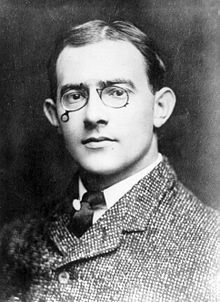
Carl Graham Fisher, a pioneer, and promoter of the automotive industry and highway construction had in 1912 conceived and helped develop the Lincoln Highway – the first roadway for automobile traffic across the entire continental United States. In 1914, Fisher followed the east-west Lincoln Highway, with the north-south Dixie Highway, connecting Michigan to Miami. He then turned his attention to developing the new resort town of Miami Beach, built upon a mostly unpopulated barrier island, connected to the mainland by the new Collins Bridge, and situated right at the southern terminus of the Dixie Highway. Widely regarded as a promotional genius, Fisher purchased a huge lighted billboard in New York’s Times Square declaring, “It’s June in Miami”.
All of this Floridian attention, development, and promotion, led to speculation and eventually to a real estate bubble which burst in 1925. But the secret was out that Florida provided a welcome respite from the harsh northern winters, and the railroads had left the Sunshine State barely more than a day’s ride from the Big Apple.
“Well, I’m going down to Florida
And get some sand in my shoes
Or maybe Californy
And get some sand in my shoes
I’ll ride that Orange Blossom Special
And lose these New York blues” – Orange Blossom Special (Rouse)
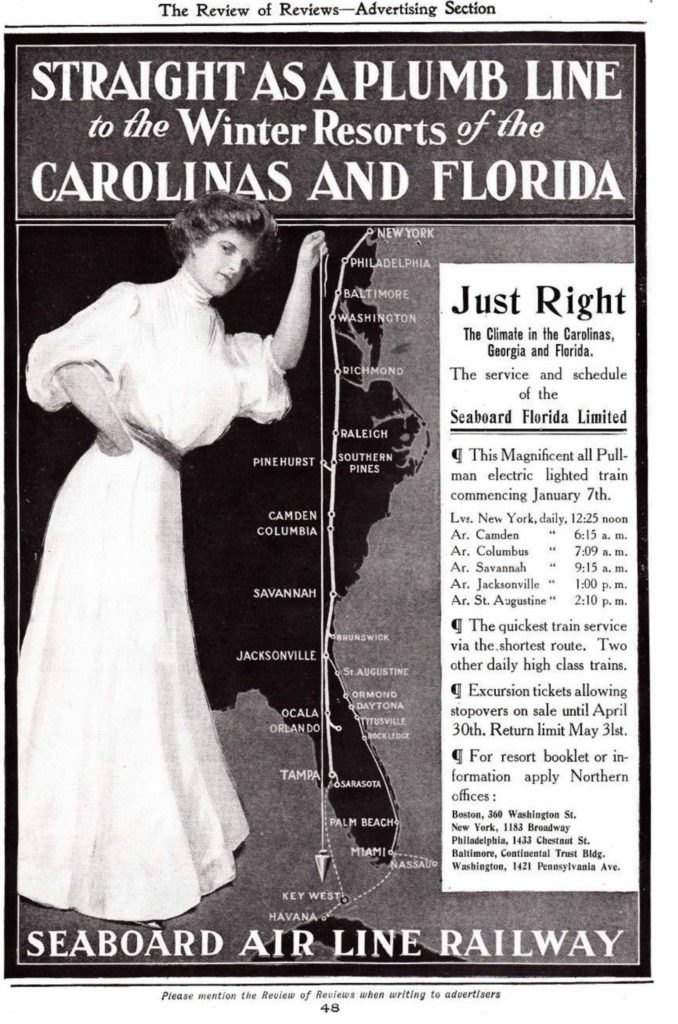
Seaboard Air Line Railroad began operation of its Orange Blossom Special on November 21, 1925. The luxury rail service was conceived by SAL’s president, S. Davies Warfield, to take advantage of the newfound interest and development in Florida, and ran in direct competition to the services offered by rival Henry Flagler’s Florida East Coast Railway.

The Orange Blossom Special was seasonal and catered to the wealthy. Operating December through April, it allowed folks in the northeastern US to escape their harsh winters. Its route covered 1,389 miles beginning on the Pennsylvania Railroad from New York City to Washington, D.C.; then connecting to the Richmond, Fredericksburg and Potomac Railroad from Washington to Richmond, and finally over the Seaboard Air Line Railroad from Richmond via Raleigh, Columbia, and Savannah to Miami. In Wildwood, Florida the train would split, with a section traveling to Tampa and St. Petersburg.
In February 1926 the “Blossom” traveled the distance from New York to West Palm Beach in 35 hours. The route would not extend to Miami until 1927. As the SAL adopted diesel power the travel times were reduced.
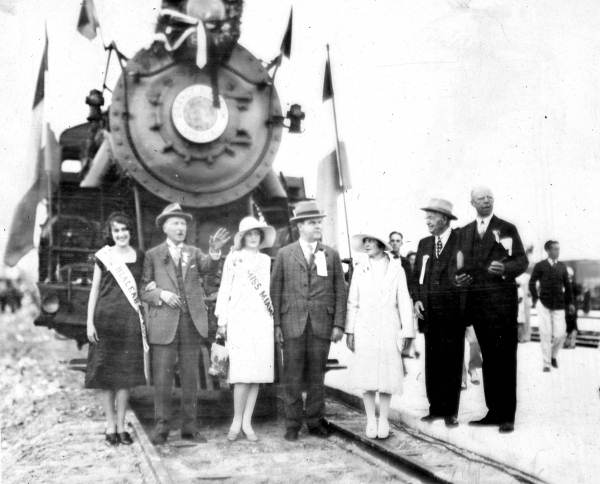
Despite the bursting of the real estate bubble, SAL president Warfield still believed in Florida as a land of opportunity to which he could lure influential, as well as wealthy business leaders, with his fast luxurious trains. The Blossom would typically depart New York after lunch, arriving in Wildwood, Florida by breakfast the next morning. After the train split in Wildwood, the sections would arrive at their Miami or St. Petersburg destinations by mid-morning to just after lunch.
As Seaboard president Davies sought to provide his passengers with the luxury, the Orange Blossom was indeed Special. Rogers Ernest Malcolm Whitaker, an editor of The New Yorker magazine who was known under the pen name of E. M. Frimbo, World’s Greatest Railroad Buff, offered this account of a dining car chef who had worked aboard the train:
“Our chef…spent nine of his forty-three years with the Pennsylvania Railroad as chef on the celebrated all-Pullman New York-to-Florida train the Orange Blossom Special—the most luxurious winter-season train ever devised by man. Nothing even remotely resembling a can opener was allowed on the premises. All the pies, cakes, rolls, birthday cakes were baked on board under his supervision. Cut flowers and fresh fish were taken on at every revictualing stop, and the train carried thirty-five hundred dollars’ worth of wine, liquor, and champagne—these at pre-Prohibition prices—for each run.”
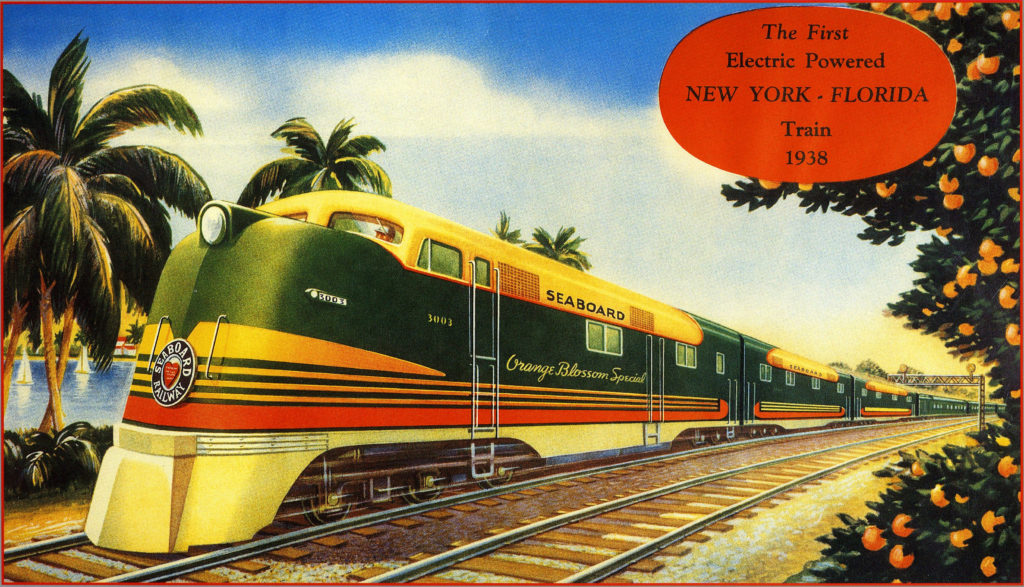
At its inception, the Orange Blossom Special’s power was typically provided by a Class M 4-8-2 steam locomotive. In October of 1938, SAL initiated the use of its new Electro-Motive E4 diesels to head the train. A 1941 timetable for southbound service shows the make-up of the train as follows: a club car, lounge, a diner, and nine sleepers, with extra cars on standby to satisfy high demand.
To accompany the train’s new diesel locomotive units, a special paint scheme was devised by General Motors artist Leland Knickerbocker, who was also responsible for Santa Fe Railroad’s “warbonnet” livery. Knickerbocker incorporated the lemon, lime, and orange colors of the Florida citrus trade into his design of what would become known as the Orange Blossom Special’s “citrus” livery. The artist would also apply for and receive patent number 113,563, for a “new, original, and ornamental design of a locomotive body.”
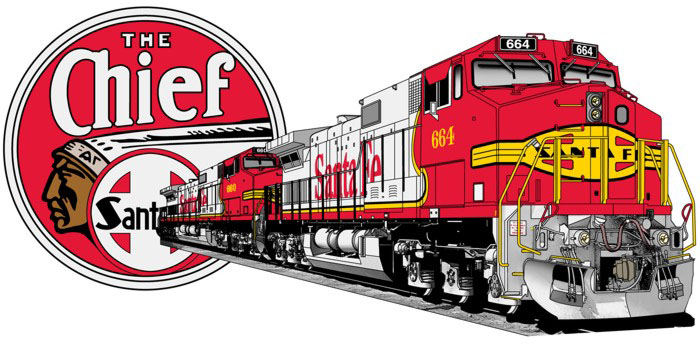
While the Orange Blossom Special’s service was interrupted during World War II, the train would continue its seasonal running through 1953, when it was replaced by Seaboard’s fully streamlined trains such as Silver Meteor and Silver Star.
“Hey talk about a-ramblin’
She’s the fastest train on the line
Talk about a-travellin’
She’s the fastest train on the line
It’s that Orange Blossom Special
Rollin’ down the seaboard line” – Orange Blossom Special (Rouse)
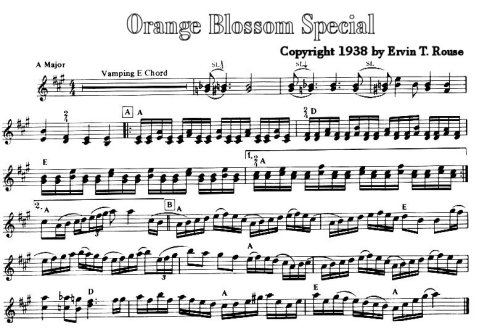
“Orange Blossom Special” – not the train, but the song – was written by Ervin T. Rouse in 1938. It was originally recorded by Ervin and his brother Gordon in 1939. A short time later the song was recorded by Bill Monroe (with Art Wooten on fiddle) and became a big hit. Originally written as an instrumental, lyrics were later added.
The song has become known not only for its imitation of train sounds, but also as a show-off piece for expert fiddlers, and has long been referred to as the fiddle player’s national anthem. By the 1950s the song had become a staple of bluegrass festivals. There are tales of the song being banned from bluegrass competitions, lest too many fiddlers choose it for the same event. One story tells of a festival in Georgia, where the fire extinguisher case sported the notice, “Break in case of the ‘Orange Blossom Special.’ ”

Over the years there have been others who have claimed to author “Orange Blossom Special”, including fiddler “Chubby Wise”, who popularized the song while playing it weekly on the Grand Ole Opry. According to Wise’s account:
“… even though it was about three in the morning we went right into the Terminal and got on board and toured that train, and it was just about the most luxurious thing I had ever seen. Ervin was impressed, too. And when we got done lookin’ ‘er over he said, “Let’s write a song about it.” So we went over to my place … and that night she was born. Sitting on the side of my bed. We wrote the melody in less than an hour and called it ‘Orange Blossom Special.’ Later Ervin and his brother put some words to it.”
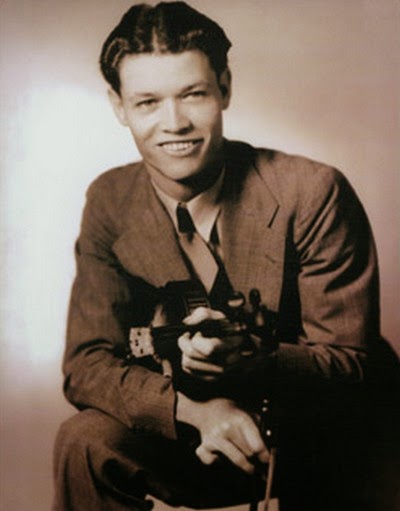
Ervin Rouse has been described as an unassuming, mild-mannered fellow who lived deep in the Florida Everglades and was never concerned about disputing Wise’s assertions. Once he was asked by a family member whether Wise had any involvement in composing the tune, to which Rouse is said to have replied, “Hell no!”
“Say man, when you going back to Florida?”
“When am I goin’ back to Florida? I don’t know, don’t reckon I ever will.”
“Ain’t you worried about getting your nourishment in New York?”
“Well, I don’t care if I do-die-do-die-do-die-do-die.” – Orange Blossom Special (Rouse)
In the words of Norm Cohen, author of Long Steel Rail: The Railroad in American Folksong:
“For many years, Orange Blossom Special has been not only a train imitation piece, but also a vehicle to exhibit the fiddler’s pyrotechnic virtuosity. Performed at breakneck tempos and with imitative embellishments that evoke train wheels and whistles, OBS is guaranteed to bring the blood of all but the most jaded listeners to a quick, rolling boil.”
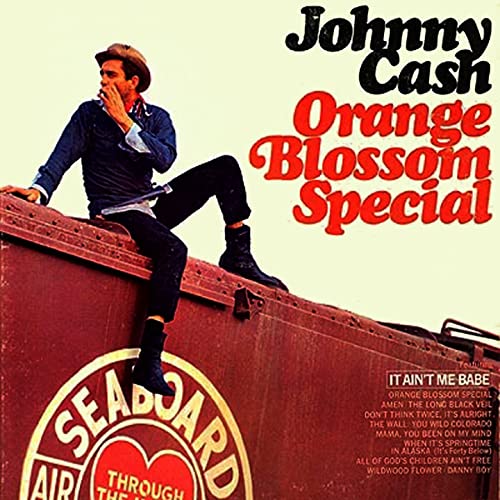
Johnny Cash titled his 1965 album Orange Blossom Special after the song while substituting harmonica & saxophone for the fiddle parts. Numerous other artists have covered the song, and it is estimated that OBS has appeared on more than 200 albums.
One such artist who was most definitely a master fiddler, and who made “Orange Blossom Special” a set-piece of his live repertoire was the recently deceased Charlie Daniels. While I can’t claim to have been well-acquainted with Daniels’ life or career beyond the familiar hits that were radio staples, upon his passing I learned just how revered he was in the music industry and the world of Country music at large. By all accounts, he was an outstanding human being, and never anything less than a gentleman. He was always willing and ready to help others when necessary and possessed an immense generosity that was bestowed upon many. And his work in support of American veterans is well noted and unsurpassed. It is to the life and career of this musical giant that I wish to dedicate this post devoted to another legendary train song.
“Look a-yonder comin’
Comin’ down that railroad track
Hey, look a-yonder comin’
Comin’ down that railroad track
It’s the Orange Blossom Special
Bringin’ my baby back” – Orange Blossom Special (Rouse)

In memory of Charles Edward Daniels (October 28, 1936 – July 6, 2020)
Sources:
https://en.wikipedia.org/wiki/Orange_Blossom_Special_(song)
https://en.wikipedia.org/wiki/Orange_Blossom_Special_(train)
https://www.american-rails.com/orange.html
https://en.wikipedia.org/wiki/Florida_land_boom_of_the_1920s
https://en.wikipedia.org/wiki/Florida_East_Coast_Railway
All photos sourced through internet searches, none belong to the author.
